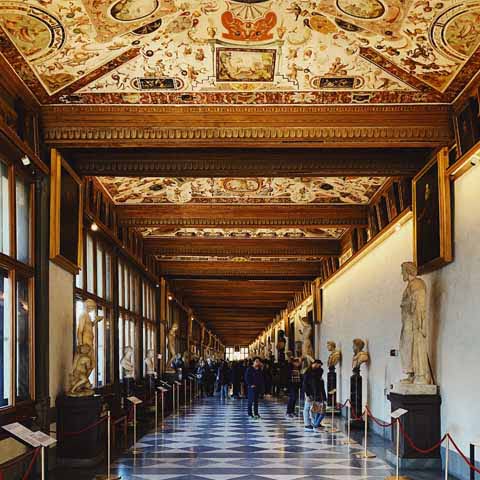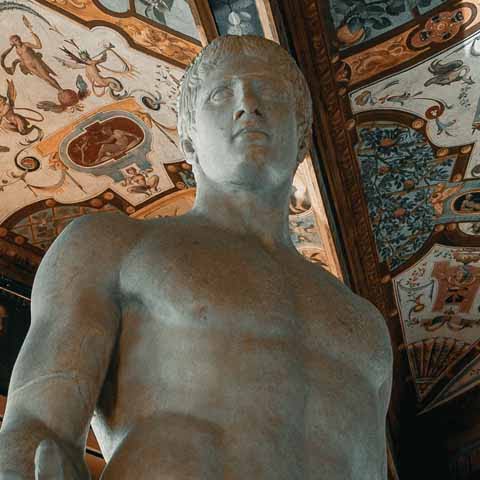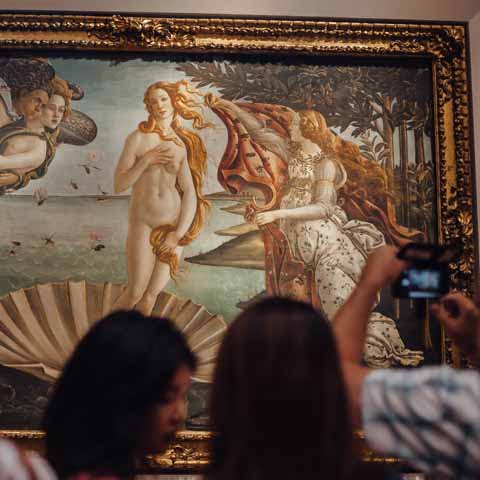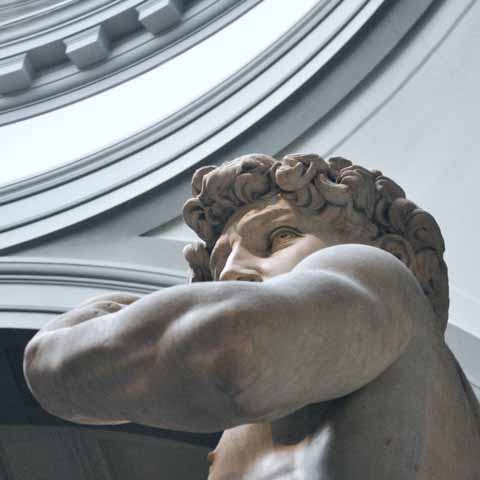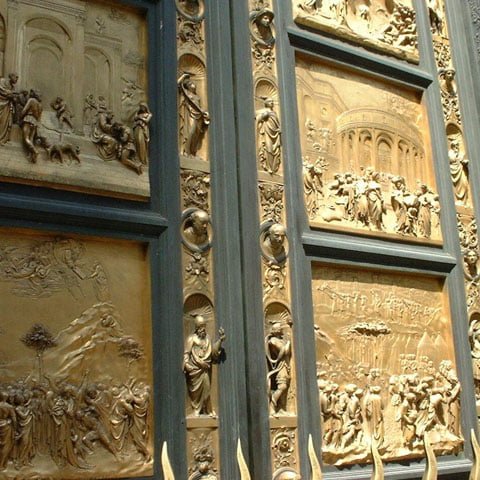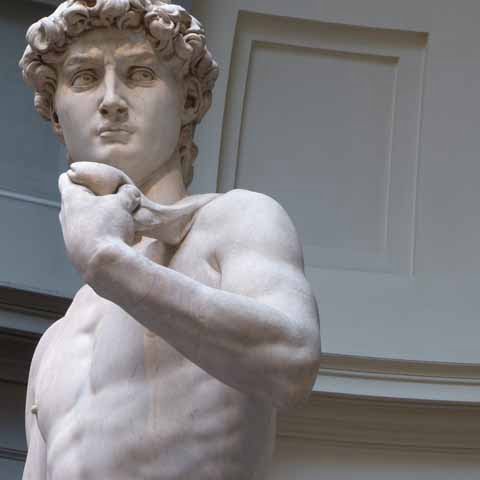Nicknamed the “Cradle of the Renaissance,” Florence history starts as a city that emerged along the Arno River in the first century BC. Initially a colony named Florentia, the settlement began to develop, evolve, and thrive during the centuries to come, becoming one of the most powerful centers of the peninsula.
Today, Florence is a large metropolitan area encompassing the city of Florence and its surroundings. From an administrative point of view, the current metropolitan area of Florence corresponds to the historic province of Florence.
Florence has inspired the world’s most renowned artists, writers, philosophers, scientists, and thinkers. As a result, the city evolved differently from others, maintaining a unique charm that still attracts travelers from all over the world.
As a result of this “illuminated” evolution, Florence became the seat of the archbishopric and one of the largest universities in Italy, not to mention all the other characteristics that make this city shine. Preserving its medieval and Renaissance charm almost unaltered and reinventing the use of ancient edifices and squares, the historic center of the city was declared a UNESCO World Heritage Site in 1982.
HISTORY OF FLORENCE
The history of Florence begins in 187 BC when the Romans decided to extend Via Cassia from Arezzo to Bologna. To survey the construction of the road, the Romans placed a military guard post on the right bank of the Arno river, more or less on the place where the city later evolved. Later on, the Roman general Sulla assigned the future territory of Florence to the Scaptia tribe, who were governing the region at the time.
However, the true development of the city did not begin until the middle of the following century, when the settlement assumed the appearance of a small Roman city. Classic Roman public buildings, including a capitol and an amphitheater, Roman spas and aqueducts were built at that time.
Christianity was likely brought to the region by merchants from the East, and the first patron saints were San Miniato and Santa Reparata. Under the Byzantine domination, the city strengthened its religious power and the bishops set up a residence in the first half of the fourth century.
Like much of Italy, Florence was attacked by the Goths over the course of the fifth and sixth centuries. The city suffered during the Gothic Wars and was besieged by Totila, the King of the Ostrogoths. The Byzantines dominated the region for a fairly long time, as is deducted from the findings of a floor in the primitive cathedral.
A series of important archaeological findings are proof of a Langobard domination as well, although the documentation about this period is scarce.
During his reign, Charlemagne is believed to have visited Florence at least twice, in 781 and in 786.
Consecrated by imperial counts and then by bishops, Florence entered a period of decline between the tenth and eleventh centuries. In fact, by the concession of Otto I of Saxony, Florence became the battlefield of struggles against the Simian clergy and revolts to abolish the Marquis of Tuscany, and in particular Marquis Matilde of Canossa.
Despite the revolts and social uncertainty, Florence’s people acquired consciousness of their own power during that period. The city was granted a certain autonomy by the Marquis, the advocate of the papacy, and the relationship between the bankers and the Florentine merchants made Florence, who at the time was less powerful than Pisa, a solid commercial center.
Close to Florence, Lucca was chosen as the seat of the marquisate and one of the Guelph towns to fight against Ghibelline cities.
The first manifestation of Florence as a free commune was during the war against Fiesole, which was won in 1125.
That same year, the new King of Italy, Lothair III, found himself unable to intervene immediately against Florence, and this situation favored the consolidation of the consular magistrate, who was supported by the nobility of the town, ecclesiastics, and merchants. The imperial intervention was, in this way, eliminated before becoming a threat.
With the powers earned, the nature of the relations between Florence and the nearby towns of Arezzo, Pistoia, Lucca, Siena, Pisa, and the Romagna region started to change and transform, with Florence securing a true hegemony. Florence’s government, ruled by the consular magistrate, became a lordship ruled by a sole Podestà.
Peace did not last long, however, and Florence engaged in other civil fights between the Guelphs and Ghibellines. To guarantee impartiality, rule of the city was assigned to a foreign Podestà. Civil fights ended with the victory of the Guelphs, in an event that marked the triumph of the merchant and artisan classes who engaged against the power of the Ghibelline feudal lords.
Under the Guelphs, Florence established an even more powerful hegemony on the neighboring Ghibelline cities, although the process was interrupted by the interventions of Frederick II and his son, Manfred. After the death of Frederick II in 1250, the merchant and artisan classes resisted against the Uberti and brought the Guelphs back to power again.
The following years were characterized by numerous victories against Volterra and Pisa, and in those times the first florin of gold emerged, one of the most valuable coins in Europe. The Guelphs reassumed full control over the city and the region after the defeat of Benevento and the death of Manfred. The Ghibellines were finally expelled, and a new constitution was formed.
The novel constitution included new magistrates, and the formal lordship was entrusted to Charles of Anjou for a period of ten years. From this moment on, Florence’s history became increasingly convulsed between attempts of pacification and constitutional challenges.
To begin with, a council of twelve “good men” was formed, who joined the Podestà and the captain of the people. The executive power was also entrusted to a different entity, and the Guelph party divided into two factions, the White and the Black. One faction was led by the wealthy classes such as bankers, merchants, and nobles. The other faction was constituted by lower classes, such as the artisan bourgeoisie and middle-class merchants.
The struggles between the two factions led to the forced exile of the White Guelphs, including Dante and the father of Petrarch, under the rule of Pope Boniface VIII. Nevertheless, during this period Florence was able to extend its dominance over various parts of Tuscany, including Siena, Pisa, Arezzo, Pistoia, and Mugello.
During the first half of the fourteenth century, Florence was forced to rely on foreign governments to deal with external threats, in 1325 and in 1342. In an almost uninterrupted evolution and territorial achievements, Florence continued its dominant policy throughout the century.
Towards the end of the fourteenth century, there was a striking contrast between social classes, and for the first time, the Medici family tried to assume the lordship of the city. At the time, the reforms disapproved.
The beginning of the fifteenth century found Florence threatened by the expansionist pressure of the House of Visconti, which ended with the Duke’s death. After the conquest of Pisa in 1406, Florence instituted its dominance throughout Tuscany, with the exception of Lucca and Siena. In an attempt to counteract the immense power of the city, Milan and Venice allied and attacked the city in 1425.
In 1434, the Medici established their lordship over the city. This was a necessary strategic move given the disagreements between the oligarchic fractions and the people. The rule of the Medici began with Cosimo the Elder, who implemented a balanced policy between the Italian states and Florence. The true balance was accomplished by his nephew, Lorenzo the Magnificent, who sped up the process of extinction of the republic.
Nevertheless, the republic was restored in 1494, two years after the death of Lorenzo, when his son Piero was expelled for showing excessive weakness in front of Charles VIII of France. Florence ended up under the rule of the Dominican friar Girolamo Savonarola, who would lead Florence until clashes with the papacy resulted in his execution. After Savonarola, a new constitution was implemented and the position of the city became increasingly weak, especially during the war for the conquest of Pisa.
The Medici, taking advantage of the retreat of the French, returned to Florence and reassumed their power until 1527, when the Florentines restored the Republic and decided to ally with France.
From then on, first under the rule of the Medici and then under the House of Habsburg-Lorraine, Florence expanded its boundaries and was eventually annexed, through the will of the popular plebiscite, to the Kingdom of Italy. Between 1865 and 1871 Florence was named the capital of the Kingdom of Italy, and the political vitality of the city did not diminish. In fact, numerous groups who participated as protagonists to the evolution of the Italian state emerged in Florence.
In the twentieth century, the city was struck by two great tragedies: the destruction of the bridges caused by attacks during World War II, and a flood in 1966 that devastated monuments, houses, museums, and libraries. Despite these setbacks, the city recovered and flourished as one of Italy’s most important travel destinations thanks to its wealth of art and history.
ARCHEOLOGY OF FLORENCE
Although famous for its Renaissance glamour, Florence boasts a few impressive archaeological sites that speak to the prehistory and history of the region.
A series of excavations carried out in Piazza della Signoria, which remained intact after 1250, the year of its last renovation, led to the identification of a Roman spa of remarkable size operating between the second and the fifth centuries AD.
During the excavations, a few materials attributed to the Bronze and Neolithic ages were also identified. A significant artifact is a foot of a tripod, commonly used in Sardinia during the Neolithic age, attesting to the commercial relations between the two regions since the third millennium BC.
Important from an archaeological point of view is a Villanovan burial ground that was discovered in the urban area, and some archaic necropolises in Fiesole, a small commune near Florence. The commune also boasts an open-air museum, the site including an Etruscan-Roman temple and Langobard necropolis, urban walls, and remains of a Roman theater and various spas.
Sesto Fiorentino is another place rich in well-preserved Etruscan monuments. One of them is the Tomb of Montagnola. The site is unique due to the conical truncated shape of the burial chambers that are reached through a corridor. The burial chambers preserve the spirit of Middle Arno Etruria and attest to the ancient history of the territory.
The Ethnographic Historical Museum in Bruscoli and the Archaeological Center of Santa Agata in Scarperia are two other important centers in the metropolitan city of Florence. The first houses rich collections of geo-archaeological finds that come from excavations along the Ancient Roman road. Bruscoli is rich in ancient trails and many pieces of evidence from the Iron Age are scattered throughout the territory. The latter is an exhibition of important archaeological finds from the western part of Mugello.
This exhibition is held only on Sundays in the Cloister of the Church of Santa Agata and it includes a vast collection of artifacts belonging to prehistory. Most of the objects document the Etruscan and Roman times. There are also some findings belonging to the Middle Ages.
Last but not least, the foundations of an ancient Romanesque church and the perimeter of a large Etruscan building, presumably a great temple, have been discovered in Poggio di Frascole. A very well-preserved funeral monument and an Archaeological Museum are also located in the area.
Travel Guides
The Tuscany Region of Italy
The Cities of Tuscany, Italy
